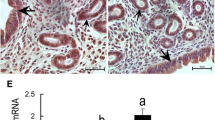Abstract
Slug, a member of the Snail family of zinc-finger transcription factors, is involved in regulating embryonic development and tumorigenesis. The aim of this study was to investigate the expression of Slug in mouse endometrium during early pregnancy and its possible role during embryo implantation. Fluorescence quantitative polymerase chain reaction and immunohistochemistry were applied to detect Slug mRNA and Slug protein expression in endometrium of nonpregnant and early pregnant mice, respectively. The expressions of Slug mRNA and its protein in pregnant group were higher than that in nonpregnant group and gradually increased from pregnancy day 1, reaching its maximum level on day 4 and then declining on days 5, 6, and 7. Immunohistochemistry showed that Slug protein was mainly present in luminal epithelium from pregnancy days 2 to 5 and in glandular epithelium from days 2 to 6 and enhanced significantly in stromal cells on days 4, 5, and 6. The number of embryos implanted was greatly decreased after Slug function in mouse endometrium was blocked by the intrauterine injection with anti-Slug polyclonal antibody on day 3 of pregnancy before implantation. These results suggested that up-regulation of Slug expression may play a key role in the embryo implantation in mice.



Similar content being viewed by others
References
Paznekas, W. A., Okajima, K., Schertzer, M., Wood, S., & Jabs, E. W. (1999). Genomic organization, expression, and chromosome location of the human SNAIL gene (SNAI1) and a related processed pseudogene (SNAI1P). Genomics, 62, 42–49. doi:10.1006/geno.1999.6010.
Kurrey, N. K., K, A., & Bapat, S. A. (2005). Snail and Slug are major determinants of ovarian cancer invasiveness at the transcription level. Gynecologic Oncology, 97(1), 155–165. doi:10.1016/j.ygyno.2004.12.043.
Nieto, M. A., Sargent, M. G., Wilkinson, D. G., & Cooke, J. (1994). Control of cell behavior during vertebrate development by Slug, a zinc finger gene. Science, 264(5160), 835–839. doi:10.1126/science.7513443.
Zhang, C., Carl, T. F., Trudeau, E. D., Simmet, T., & Klymkowsky, M. W. (2006). An NF-kappaB and slug regulatory loop active in early vertebrate mesoderm. PLoS ONE, 1, e106. doi:10.1371/journal.pone.0000106.
Turner, F. E., Broad, S., Khanim, F. L., et al. (2006). Slug regulates integrin expression and cell proliferation in human epidermal keratinocytes. The Journal of Biological Chemistry, 281(30), 21321–21331. doi:10.1074/jbc.M509731200.
Hajra, K. M., Chen, D. Y.-S., & Fearon, E. R. (2002). The SLUG zinc-finger protein represses E-cadherin in breast cancer. Cancer Research, 62, 1613–1618.
Moreno-Bueno, G., Cubillo, E., Sarrió, D., et al. (2006). Genetic profiling of epithelial cells expressing e-cadherin repressors reveals a distinct role for snail, slug, and e47 factors in epithelial-mesenchymal transition. Cancer Research, 66(19), 9543–9556. doi:10.1158/0008-5472.CAN-06-0479.
Kajita, M., McClinic, K. N., & Wade, P. A. (2004). Aberrant expression of the transcription factors snail and slug alters the response to genotoxic stress. Molecular and Cellular Biology, 24(17), 7559–7566. doi:10.1128/MCB.24.17.7559-7566.2004.
Castro Alves, C., Rosivatz, E., Schott, C., et al. (2007). Slug is overexpressed in gastric carcinomas and may act synergistically with SIP1 and Snail in the down-regulation of E-cadherin. The Journal of Pathology, 211(5), 507–515. doi:10.1002/path.2138.
Murray, M. J., & Lessey, B. A. (1999). Embryo implantation and tumor metastasis: Common pathways of invasion and angiogenesis. Seminars in Reproductive Endocrinology, 17(3), 275–290. doi:10.1055/s-2007-1016235.
Paria, B. C., Huet-Hudson, Y. M., & Day, S. K. (1993). Blastocyst’s state of activity determines the "window" of implantation in the receptive mouse uterus. Proceedings of the National Academy of Sciences of the United States of America, 90, 10159–10162. doi:10.1073/pnas.90.21.10159.
Bolós, V., Peinado, H., Pérez-Moreno, M. A., Fraga, M. F., Esteller, M., & Cano, A. (2003). The transcription factor Slug represses E-cadherin expression and induces epithelial to mesenchymal transitions: A comparison with Snail and E47 repressors. Journal of Cell Science, 116(Pt 3), 499–511. doi:10.1242/jcs.00224.
Wang, Z., Wade, P., Mandell, K. J., et al. (2007). Raf 1 represses expression of the tight junction protein occludin via activation of the zinc-finger transcription factor slug. Oncogene, 26(8), 1222–1230. doi:10.1038/sj.onc.1209902.
Martínez-Estrada, O. M., Cullerés, A., Soriano, F. X., et al. (2006). The transcription factors Slug and Snail act as repressors of Claudin-1 expression in epithelial cells. The Biochemical Journal, 394(Pt 2), 449–457. doi:10.1042/BJ20050591.
Xing-hong, M. A., Shi-jun, H. U., Hao, Y. U., Li-bin, X. U., & Zeng-ming, Y. A. N. G. (2006). Differential expression of transcriptional repressor snail gene at implantation site in mouse uterus. Molecular Reproduction and Development, 73, 133–141. doi:10.1002/mrd.20429.
Gray, C. A., Bartol, F. F., Tarleton, B. J., et al. (2001). Development biology of uterine glands. Biology of Reproduction, 65, 1311–1323. doi:10.1095/biolreprod65.5.1311.
Kayisli, O. G., Kayisli, U. A., & Rejjal, R. A. (2003). Regulation of PTEN (Phosphatase and tensin homolog deleted on chromosome 10) expression by estradiol and progesterone in human endometrium. The Journal of Clinical Endocrinology and Metabolism, 88(10), 5017–5026. doi:10.1210/jc.2003-030414.
Ingman, W. V., & Robertson, S. A. (2002). Defining the actions of transforming growth factor beta in reproduction. BioEssays, 24(10), 904–914. doi:10.1002/bies.10155.
Kamijo, T., Rajabi, M. R., Mizunuma, H., & Ibuki, Y. (1998). Biochemical evidence for autocrine/paracrine regulation of apoptosis in cultured uterine epithelial cells during mouse embryo implantation in vitro. Molecular Human Reproduction, 4(10), 990–998. doi:10.1093/molehr/4.10.990.
Choi, J., Park, S. Y., & Joo, C. K. (2007). Transforming growth factor-beta1 represses E-cadherin production via slug expression in lens epithelial cells. Investigative Ophthalmology & Visual Science, 48(6), 2708–2718. doi:10.1167/iovs.06-0639.
Acknowledgments
We thank Professor MaoSheng YANG for his constructive comments on the manuscript and Doctor Qiong Shi at the Center for Medicine Probation at the Chongqing Medical University in China for the guidance and proposition of FQ-PCR. We apologize for unintended omission of any relevant references.
Author information
Authors and Affiliations
Corresponding author
Rights and permissions
About this article
Cite this article
Du, F., Yang, R., Ma, HL. et al. Expression of Transcriptional Repressor Slug Gene in Mouse Endometrium and its Effect During Embryo Implantation. Appl Biochem Biotechnol 157, 346–355 (2009). https://doi.org/10.1007/s12010-008-8521-8
Received:
Accepted:
Published:
Issue Date:
DOI: https://doi.org/10.1007/s12010-008-8521-8




